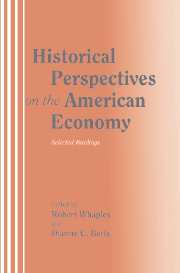Book contents
- Frontmatter
- Contents
- Acknowledgments
- Introduction to students
- Introduction to instructors
- Contributors
- I Introduction
- II Colonial and early national economy
- III Slavery and servitude
- IV The South since the Civil War
- V The rise of American industrial might
- 10 “The railroads: The first modern business enterprises, 1850s–1860s”
- 11 “Notes on the social saving controversy”
- 12 “Industrial structure and the emergence of the modern industrial corporation”
- 13 “The origins of American industrial success, 1879–1940”
- 14 “Federal policy, banking market structure, and capital mobilization in the United States, 1863–1913”
- VI Populism
- VII Women in the economy
- VIII The Great Depression
- Appendix: Basics of regression
- Glossary
- Name index
- Subject index
12 - “Industrial structure and the emergence of the modern industrial corporation”
Published online by Cambridge University Press: 05 June 2012
- Frontmatter
- Contents
- Acknowledgments
- Introduction to students
- Introduction to instructors
- Contributors
- I Introduction
- II Colonial and early national economy
- III Slavery and servitude
- IV The South since the Civil War
- V The rise of American industrial might
- 10 “The railroads: The first modern business enterprises, 1850s–1860s”
- 11 “Notes on the social saving controversy”
- 12 “Industrial structure and the emergence of the modern industrial corporation”
- 13 “The origins of American industrial success, 1879–1940”
- 14 “Federal policy, banking market structure, and capital mobilization in the United States, 1863–1913”
- VI Populism
- VII Women in the economy
- VIII The Great Depression
- Appendix: Basics of regression
- Glossary
- Name index
- Subject index
Summary
Introduction
Alfred D. Chandler, Jr.'s thesis that the modern U.S. industrial corporation evolved in response to the technological changes in the latter half of the 19th century has been widely acclaimed and has had a profound impact on contemporary thought regarding the business enterprise (Chandler, 1977; Williamson, 1981, 1982). Unfortunately, it has not been subjected to rigorous empirical testing, which reflects not a lack of interest in his ideas but rather the unavailability of appropriate data for the entire period and the difficulties in modeling many of the qualitative factors in the model. Although this paper does not overcome all of these problems, it represents the first systematic attempt to address the core of Chandler's thesis with quantitative evidence.
In the long run, competition, whether pure or tainted by elements of monopoly, tends to drive less efficient producers out of business. Using this observation and counterfactual analysis, I develop an indirect and admittedly incomplete test of Chandler's key argument that the modern business corporation evolved by taking advantage of continuous production process technologies and the opportunities afforded by the railroad and declining transport costs to market a high volume of production nationwide. This is accomplished by measuring the extent to which the average industrial firm at the end of the century (when most of the developments discussed by Chandler had taken place) differed in size from firms that survived the Civil War decade, that is, prior to such changes.
- Type
- Chapter
- Information
- Historical Perspectives on the American EconomySelected Readings, pp. 428 - 454Publisher: Cambridge University PressPrint publication year: 1995



